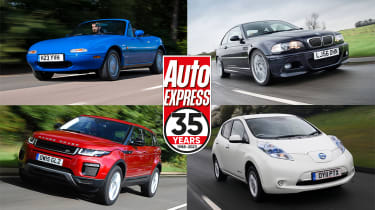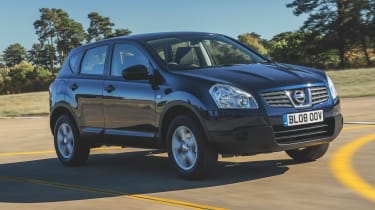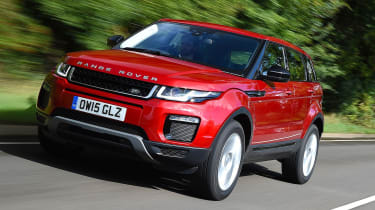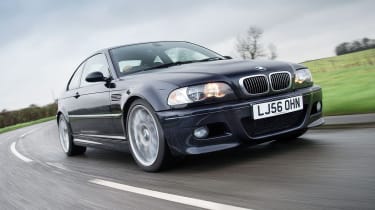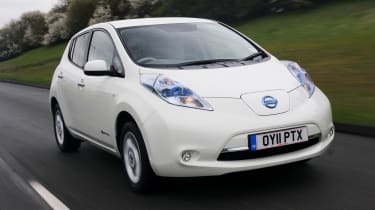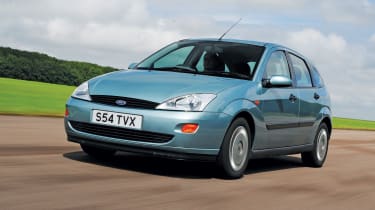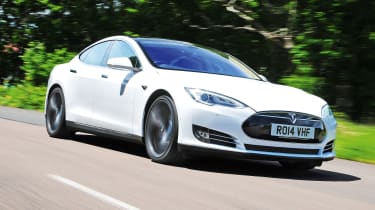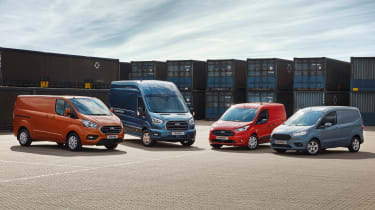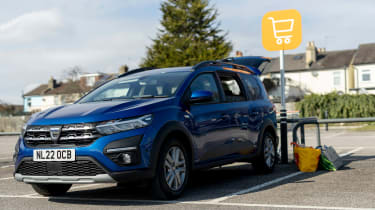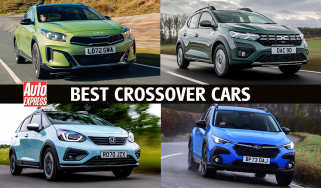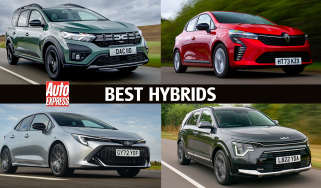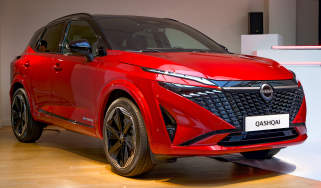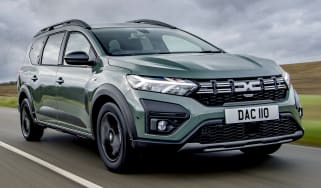The most important cars of the last 35 years
We’ve reviewed hundreds of models over the past 35 years, but these are the ones that our team believes really made a difference
After more than three decades covering breaking motoring news and reviewing the very latest cars, Auto Express has certainly seen a huge amount of change throughout its lifetime - that and a huge number of new cars.
With so many new models having arrived on the market over the 35 years that Auto Express has been in existence, it takes a particularly special one to be recognised as a true pioneer. Which cars really changed the face of the car market with their innovation and are really worthy of being named as the most important of the last 35 years?
There are, of course, plenty of candidates, so we’ve asked each member of the Auto Express team to make the case for an influential car of their choice. In order to qualify for this list, each model had to have made a truly groundbreaking difference to the motoring world.
What are the most important cars of the last 35 years?
Read on to find the cars that we think are the most important and influential models of the past three-and-a-half decades.
Nissan Qashqai Mk1
Steve Fowler
When it comes to naming the most important car of the past 35 years, a pretty good place to start is with the car that, five years ago, took the title of the most important car of the last 30 years. The Nissan Qashqai remains an icon, a benchmark and a huge seller.
We’re now on to the third generation of Qashqai, which was launched in 2021. As with the original and second generation, the Mk3 can be considered a British success story. Much of the styling work for all three cars was done at Nissan Design Europe HQ in Paddington, London, which celebrates its 20th anniversary this year.
A lot of the engineering for all three cars was done by the team at Nissan’s European Technical Centre in Cranfield, Bedfordshire – as with Auto Express, NETC celebrates its 35th birthday this year. And, of course, the Qashqai has – since its launch in 2006 – been built at the famous factory in Washington, Tyne and Wear.
Its winning recipe saw it become the UK’s best-selling new car in 2022 with 42,704 finding homes, nearly 7,000 more than the second-placed Vauxhall Corsa.
The Qashqai story began in 2002 when Nissan started work on a replacement for the Almera hatchback. By 2004 a Qashqai concept was shown at the Geneva Motor Show, receiving such a positive response that it was put into production in 2006, making its debut at that year’s Paris show. It ended up replacing not only the Almera, but also the bigger Primera family car.
Like all of the best ideas, the Qashqai was a simple proposition: the size, driving dynamics and running costs of a Volkswagen Golf-sized family hatchback but with the style, practicality and desirability of an SUV.
Also like the best of ideas, it was copied. Without the Qashqai, we wouldn’t have had the Volkswagen Tiguan – and its sister cars from Audi, Skoda, SEAT and Cupra – BMW’s small SUVs such as the X1 and X2, Hyundai’s Tucson and Kia’s Sportage, with a host of Qashqai-sized rivals coming this way from China, too. It’s no surprise that the forthcoming Omoda C5 and Seres 3 not only look like the Qashqai, but they’re within millimetres of the Nissan’s dimensions – those brands know what works.
The Qashqai didn’t just give other car makers good reason to develop their own similar-sized models, it gave Nissan the confidence to try the same thing again, only smaller. The Juke would never have been conceived had it not been for the Qashqai’s success. It, too, has a British heart and has been copied.
Whether the Qashqai survives into the fully electric era remains to be seen. We already have the Nissan Leaf, set to be reinvented as a crossover, and there’s the bigger Ariya, the Auto Express Car of the Year in 2022. That doesn’t mean the Qashqai can’t innovate; the e-Power hybrid is unlike any other and uses a petrol engine driving a generator to supply electric power for driving. But the Qashqai has defined one of the most popular genres of cars of the past 35 years.
Range Rover Evoque Mk1
John McIlroy
Land Rover has made some astonishing strides over the past 35 years, but most of them have been based on the core value that has underpinned the brand since day one: go-anywhere ability. However, back in 2011, the company launched a vehicle that refined what a Land Rover could be: the Range Rover Evoque.
The original concept that previewed the Evoque, the LRX, was badged as a Land Rover. But at some point the team at Gaydon realised that the car they were working on was actually better suited to being a baby Range Rover – with the accompanying profit margins.
The Evoque was a triumph of engineering and design working hand in hand, from the neat bodywork tricks required to deliver the LRX’s distinctive, chunky stance to the stellar work carried out to ensure that the Ford-derived underpinnings were still able to go further off road than any of the model’s rivals.
Except there were few obvious, genuine competitors. The Evoque helped to define the market of small premium SUVs, just as the original Range Rover had set out its stall as the first luxury off-roader. The design, fit and finish meant it looked as much at home in a muddy country lane as it did outside a snazzy restaurant.
We’re now well into the Evoque’s second generation and it continues to do the numbers for JLR. It’s also easy to see how it could, and should, be one of the firm’s first vehicles to make the transition to pure-electric motoring. The urban Range Rover is every bit as much of a sales smash today as it was more than a decade ago.
BMW 3 Series E46
Alex Ingram
I’m no bookmaker, but if I was to state the chances of BMW producing another brilliant 3 Series when the Neue Klasse concept evolves into the latest generation of the four-door saloon, I’d give it the same odds as I would for Max Verstappen wrapping up the 2023 Formula One title. And much like Verstappen’s titles, I only need to look at past form to conclude that it’s a safe bet.
Some of my colleagues will have picked more revolutionary, more affordable and more practical cars for this list. But almost none will have offered such a broad range of abilities so consistently for 35 years. And that’s before you get to the badge; this is a premium car that’s not only attainable, but is desirable, too. BMW is yet to produce a dud.
Whether we’re driving the current G20 model or the Mk2 E30 – which was just approaching the end of its life as Auto Express started out – all have been class leaders when viewed as an overall package, delivering consistently superb ride and handling, brilliant engines, and more recently, class-leading in-car tech. They’re the standard against which cars such as the Mercedes C-Class, Audi A4 and other competitors have been judged – and still are.
Then there’s the versatility. The bread and butter of the ranges are available in saloon and estate forms, and until the divergence of the two-door models into the separate 4 Series in 2013, coupe and convertible styles, too. ‘Touring’ estate versions give the same sharp driving experience, but with the added benefit of a spacious boot and a smart split-tailgate design.
So which is best? That’s a tough question, but for its versatility of engines and bodystyles, its brilliant build quality and refinement, great handling and the sublime M3 – even more joyous in the motorsport-inspired CSL version – I’d put the E46 right up there.
Mazda MX-5 Mk1
Dawn Grant
There’s one car that stands out for me over the past 35 years, and it’s the Mazda MX-5. In fact, the Japanese roadster launched just a year after the magazine, so it’s been a kind of constant for me during my time at Auto Express. It obviously means a lot to many other people, too, because Mazda’s icon is the world’s best-selling two-seat soft-top, shifting more than a million units over four generations.
The MX-5 embodies many qualities that we love at Auto Express: primarily that it’s affordable and attainable, but here price has never compromised driving fun, which are two of its great qualities.
We’ve tested and reviewed various iterations over the years, and I’ll never forget my first go in an MX-5. From the simplicity of the roof mechanism – you need just one hand to unclip the catch and fold the soft-top down, keeping the car’s price and its kerbweight low – to the feel of the gearchange and the steering, there’s nothing else like it.
In fact, the low weight - all MX-5s have weighed around a tonne - means the car has mostly bucked the trend of getting bigger and heavier as time has passed, so all of its strong points are as obvious today as they were in 1989.
Those key elements are super-sharp, accessible handling for all, a lovely gearbox, sweet, precise steering and an engine that has managed to avoid the trend for turbocharging. It requires you to rev it a bit as a result, but that’s part of the fun – and the raspy note when you do means it’s worth it.
There have been commemorative models and special editions, while it created a whole economy for tuners and specialists offering performance modifications. But I think the MX-5 is best as Mazda intended it, whatever generation you buy, with a naturally aspirated engine and a manual gearbox in a lightweight, pure and simple chassis that delivers a level of enjoyment that few cars can match.
Nissan Leaf Mk1
Andy Pringle
If you want to understand why I think the original Nissan Leaf is the most important model of the past 35 years, just start reading the review. The first adjective we use to describe it is “pioneering”, and within the first couple of paragraphs, we call it a “groundbreaking” car that “blazed a trail”.
Praise indeed – and not without good reason. Yes, there had been electric cars before, but the Leaf has secured its place in history because it was the first car from a mainstream maker to bring electric motoring to the masses.
These days EVs are everywhere, yet the Leaf drove into a very different motoring landscape when it first went on sale in the UK in March 2011. Next to similarly sized cars, such as the Ford Focus, Vauxhall Astra and Volkswagen Golf, electric propulsion made it unique.
It’s also hard to overstate just how different it looked, but the boldly bug-eyed Leaf proved that an EV was a genuine proposition for everyday motoring for everyday people. It was a five-door family hatchback that set out to offer a zero-emission alternative to some of the mainstays of the UK car market – and it had the reassurance of wearing the same badge as a Micra or a Qashqai.
Sitting here in 2023, there can be no doubt that electric cars are the future – for many, they’re already the present. But without a supremely bold Nissan paving the way, it’s a future that might have taken a lot longer to arrive.
MINI R50
Steve Walker
The original Mini is a British design icon that’s quite rightly held up as one of the most important cars of all time. So when BMW reinvented it as the MINI in 2000, it’s fair to say there was some controversy.
BMW at the time, still defined by straight-faced Teutonic efficiency, probably wasn’t the brand you’d have backed to pull off a modern-day version of a quirky, retro British runabout. In the event, the Germans did it all under a revamped MINI brand marketed with its own cheekily rebellious character to create some distance to BMW’s executive saloons.
More importantly, the Frank Stephenson-designed car didn’t just ape the original’s look, it captured at least some of its essence. Where Volkswagen’s New Beetle, launched in 1997, had cynically dropped a curvy Beetle body onto Mk4 Golf underpinnings, the MINI felt a far more cohesive and authentic proposition. Inside and out, it respectfully updated the classic design themes while retaining a driving experience that was immediate and fun, despite its larger size.
The MINI’s timely arrival came as premium brands were successfully venturing into smaller market sectors for the first time and proving the public’s willingness to pay a premium for a compact car of elevated style and quality. The Audi A3 and Mercedes A-Class were well established and Audi had just followed up with its futuristic A2 supermini. The MINI trumped them all for sheer character and became the fashionable small car to have in the early years of the century, particularly in the UK where the connection to the beloved original still carried so much weight.
Ford Focus Mk1
Sean Carson
Before the Focus, there was the Escort. Ford’s ageing family car was in the doldrums, with poor sales due to substandard ride and handling, plus sluggish performance hurting its appeal.
The arrival of the angular new Focus prompted a huge shift in the family hatchback market, and Ford’s newcomer drove as sharply as it looked. Clever rear suspension meant the Focus possessed the kind of control and balance that some hot hatches of the time couldn’t match, while it also helped packaging.
Today, the original Focus is more supermini-sized, but back when the car was released in 1998 it packed plenty of practicality, as well as an interior design that was as revolutionary as the exterior.
The likes of Vauxhall’s Astra, the Nissan Almera and even the Volkswagen Golf were blown away by the breath of fresh air that was the Ford Focus. I always loved the look of the original version, especially in three-door form. It wasn’t until after I passed my test in 2004 that I got the opportunity to drive one, and it didn’t disappoint. I remember the snicky gearshift, while the engine was from a time before turbos when you had to work it to find some performance. It was a 1.6 with 100bhp, but it felt fast enough to me – and fun.
The steering was superb and even with my relative lack of experience behind the wheel, having just two years under my belt, I still knew there was something special about Ford’s family model.
Tesla Model S
Richard Ingram
Electric cars have come a long way in a very short time. Rewind 10 years and your choice would have been limited to a few city cars, such as the Nissan Leaf, with a restricted range and slow charging speeds, and that’s before you considered the state of the national network and topping up away from home.
At this point, EV evangelists had been casting their glance across the pond, fascinated by a new electric car called the Tesla Model S that was taking the US by storm. With its long range and spacious interior, this was an electric family car capable of managing motorway miles with ease – thanks not least to the maker’s game-changing Supercharger network.
Then, in 2014, the Model S launched in the UK and Europe and immediately re-wrote the EV rulebook. Early quality concerns aside, the Tesla’s big battery meant a reliable 200-plus-mile range, while access to the rapidly expanding Supercharger network made long journeys a cinch. I challenged this theory the following year when I drove from London to Amsterdam in a Model S P100D, with not so much as a faulty connector to damage the dream.
That specific car totally altered my barometer of what a long-distance executive car could do. Stonking straight-line speed, superb refinement and impressive comfort, the Model S had everything I wanted from a car capable of dispatching 350 miles in a day. The ability to plug and play at the various charging stations en route felt like the future. Almost a decade later, I’ve barely looked back; I now drive EVs every day.
Ford Transit
Dean Gibson
Back when Auto Express was launched, Ford dominated the new-car sales charts with its Escort and Fiesta ranges, but a lot has changed for the company in 35 years. The Fiesta is no more, the Escort died when the Focus arrived in 1998, but even that model isn’t for this world much longer, while the Sierra made way for the Mondeo, which has since made way for a range of SUVs.
But there’s one Ford product that has gone from strength to strength in the same period, and has lived up to its old marketing slogan of being the backbone of Britain: the Ford Transit.
Amazingly, the Transit was just two years into its second generation when Auto Express launched, with the original having served for more than 30 years as the model that shaped the commercial vehicle sector as we know it today. The Mk2’s wedge-shaped front end was in-keeping with other products of the time such as the Sierra, and the look evolved with the Transit Mk3 that arrived in 2000.
When the fourth generation was revealed in 2014, Ford took the Transit badge and used it as an umbrella to create a whole family of models – proof that creating spin-off brands – I’m looking at you, JLR – is nothing new. The Transit grew in size, which made space in the line-up for the medium-sized Transit Custom, while the smaller passenger car-based Transit Courier and Transit Connect completed the family.
And so it remains today, with the four models putting in sales figures that mean the Transit not only outsells Ford’s passenger cars, but puts it ahead of the leaders in the new-car sales charts. It’s arguable that you could describe Ford as a commercial vehicle maker that just happens to build cars as well.
Dacia Jogger
Darren Wilson
Thirty-five years ago, Dacia was a little-known brand confined to producing simple, affordable vehicles in its domestic Romanian market. These days the Renault-owned firm is one of the greatest success stories of the European car industry, with booming demand for its good-value offerings.
The Jogger typifies Dacia’s clever thinking: give buyers what they need, and don’t expect them to pay for anything they don’t. How else could you come up with a genuine seven-seater based on the same platform as a Renault Clio?
Like most modern Dacias, the Jogger has an appeal that grows long after you’ve first looked at its slightly awkward styling. There’s a kink somewhere around the front doors, designed to lift the roofline and allow enough headroom for the second and third rows of passengers. The cabin is stock Dacia fare, with the same controls as the big-selling Sandero supermini. Everything is logical, with simple, physical controls.
The car’s real genius is in the rear cabin, where you can fit four adults in comfort, and five with a slight squeeze across the middle row. You can remove the rear pair of seats entirely to help free up 2,085 litres of boot capacity. Dacia has even developed a kit that unfolds into a double bed, so you can use it as a mini campervan.
Subscribe to the UK's favourite car magazine: get Auto Express delivered every week...

